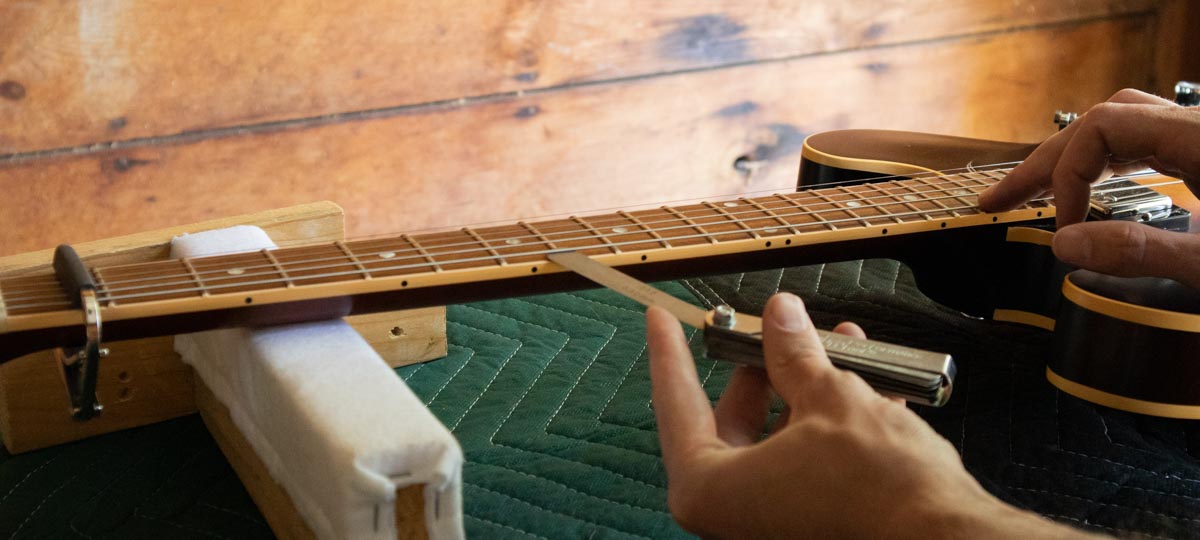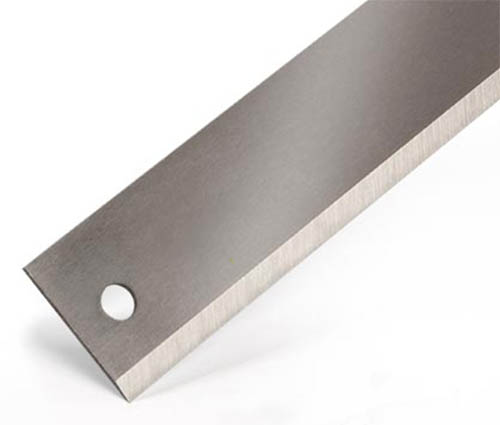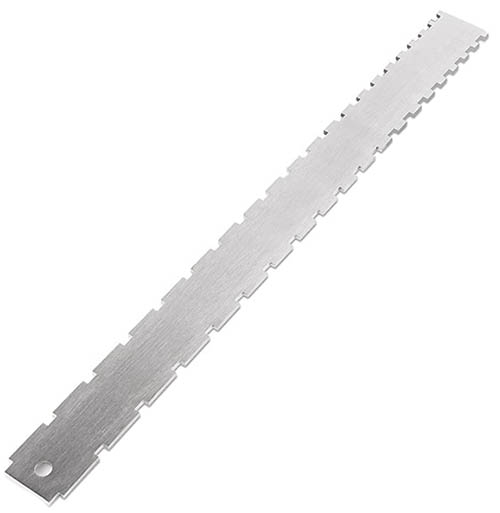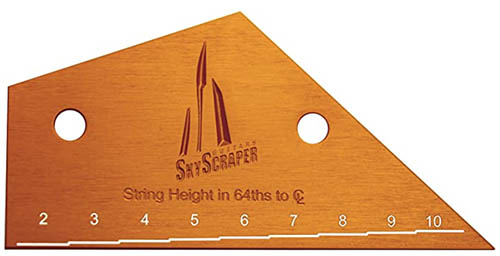Learning how to adjust the neck of your guitar through the truss rod is an easy task that simply takes some patience and a couple tools. However, the harder part is often knowing when it is actually necessary to make an adjustment to the guitar’s neck. In this article we dive into the specific reasons and conditions to look out for that may indicate your guitar needs a truss rod adjustment.
For an in-depth look at How to Adjust a Guitar’s Truss Rod check out this article: Setup Like a Pro: Correctly Adjust the Truss Rod in the Guitar Neck.
Your guitar might need a neck adjustment if:
- Certain notes are “choking out”, or not ringing clearly
- You can hear a metallic buzz coming from the frets
- The string “action” (distance from string to fret) has increased
- The guitar has moved climates (for example, from high to low humidity)
- Putting a capo on the guitar causes buzzing
- The guitar feels tight, and bending strings is difficult.
Sometimes fret buzzing located in specific areas of the neck can be resolved by a truss rod adjustment, however this is often an indication that there is a fret issue with a specific fret or two. Adding a bit of relief into the neck can often resolve these issues but can introduce others.
If you think your guitar is having fret issues, bring it to a professional, or start learning about fret work.
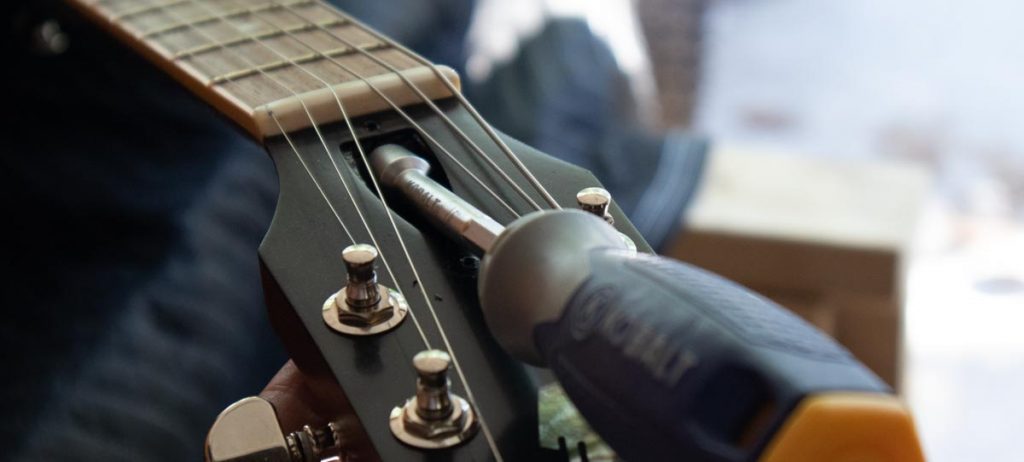
Let’s take a look at each of the above reasons for a neck adjustment and determine the correct action to take.
Notes are choking out
Notes that aren’t ringing clearly are either exhibiting fret buzz on the light end, or choking out entirely on the severe end. If this is happening on large areas of the neck, multiple notes, or multiple frets, that’s a pretty good indication that the neck is either too straight, or even back-bowed and needs some relief added to it. Check out How to measure relief.
Metallic buzz from frets
This is either called fret buzz, or fret noise and can be an indication of a too straight neck or a back-bowed neck. However, it can also indicate high or low frets that need localized attention. Adding a bit of relief can sometimes help this situation but can cause a poor setup with poor playability.
String action is too high
This can often happen with a change in the weather (temperature or humidity), or a change in string tension after changing strings to a heavier gauge. In this case, tightening or removing relief from the neck should bring the action back to a reasonable level.
The guitar has moved climates
As noted above, temperature and humidity changes can have drastic effects on the wood of your guitar. This happens most of the time if a guitar is shipped, or moved large distances to different climates. However, this can also happen with the changing of the seasons. Adjusting the truss rod is an important skill for any guitar player as it is an operation that needs to be performed regularly.
A capo is causing buzzing
If a capo on your guitar is causing fret buzz, that is a good indication that you have a fret, or series of frets that are too high. Use a fret rocker and straightedge to determine which frets are high and if a neck adjustment resolves the issue. Otherwise some fret work from a qualified tech may be in order. Add a little bit of relief to the neck to determine if the slight neck adjustment helps solve the problem.
The guitar feels tight to play and bending is difficult
The truss rod adjustment in a guitar neck really determines the playability of the guitar. If the guitar has a tight feeling to it, this is a good indicator that the string action is too low and the neck is either too straight or has a slight back-bow. Add some relief into the neck to determine if that helps the guitar play better.
Table of Contents
What the Truss Rod Adjustment Can and Can’t Do
Adjusting the truss rod can resolve some multi-fret buzz, and some localized buzzing. If the buzzing is a result of a neck that is perfectly straight or even back-bowed, then a neck adjustment may fix the problem entirely.
However, adding relief into a neck in order to remove fret buzz caused by a high or low fret can often lead to a guitar with too high of string action which results in the strings being too high making the guitar difficult to play.
Because of this, it’s important to note that a neck adjustment can’t make up for bad frets. It may help mitigate the problem but introduces other issues that could affect the playability of the guitar.
A neck adjustment can also make up for a fret board that isn’t perfectly level. Similarly however, this can only go so far as too much adjustment will introduce unwanted characteristics like high action and poor playability.
Ultimately, truss rod adjustments should be made to setup a guitar correctly instead of to cover up fret and fingerboard issues. If this is the case, take your guitar to a professional or learn how to perform fretwork yourself.
Tools for Neck Adjustments
First and foremost, to make any adjustments to your guitar neck you will need the appropriate allen wrench, nut driver, or screwdriver. Check out the table in this link to figure out which wrench your guitar’s truss rod needs. Truss Rod Wrench Lookup.
You may also need a small screwdriver to gain access to the truss rod adjustment as is the case in Gibson guitars. You also may need a large screwdriver to loosen the neck screws and pull the neck away from the body to make the adjustment like in most vintage Fender guitars, though there are many in production like that today.
While you can get away with fewer tools, having these next three specialized pieces makes fretwork much, much easier.
A good long straight edge is incredibly important to determine the level and consistency of all of the frets together. Just because the neck of the guitar is perfectly straight doesn’t mean that the top of the frets are as well.
A good straight edge will immediately if you have high or low frets that are going to be causing issues.
A notched straightedge has material removed so that the frets don’t touch the metal. Instead of testing the straightness of the top of the frets, with this tool you test the straightness of the wood fretboard itself.
This is incredibly important because quite often the top of the frets do not match the fingerboard. To most accurately set up a guitar neck, first use the notched straightedge to get the fingerboard perfectly level. If the fingerboard is not level or has high and low spots, the frets need to be removed and the fretboard sanded back to level before new frets are installed.
While this is a specialized tool, it makes true diagnostics of the guitar neck possible where it would otherwise be impossible to tell the exact straightness and condition of the neck. Again, this is the only way to truly get the neck perfectly straight.
For detecting high and low frets on shorter spans of the neck, get a fret rocker. These tools are inexpensive and have multiple sides with differing lengths, allowing for the isolation of specific frets. These are inexpensive and incredibly useful. If I had to get one of these three tools to help set up my guitar neck, this would be the one I’d start with.
While straightedges aren’t the most exciting tools, it’s important not to skimp on that purchase. A straightedge has one job. To be straight. Inexpensive options are often made from softer materials that will lose their straightness over time, or may not even be perfectly straight to begin with. I highly recommend going with the StewMac tools which are made to the highest quality spec.
Purpose of the Truss Rod
The truss rod of the guitar helps to stabilize the neck from too much movement, and provide additional support to counteract the forces of the guitar strings under tension.
Most guitars feature an adjustable truss rod that can be tightened to introduce relief, or bow into the neck. Most guitars don’t play that well without a small amount of relief in the neck. Perfectly straight necks are rare on a well setup guitar.
As detailed above, adjusting the truss rod can help alleviate some fret noise, but mostly is used for a playability adjustment. Too little relief in the neck will cause a guitar to play tight, too much relief in the neck and the guitar will have too high of action causing the guitar to be difficult to play and can introduce intonation problems.
Level Frets vs Level Neck
Standard neck adjustments adjust for the top of the frets, or the average of the top of the frets. In a practical sense this makes the most sense as the strings touching the top of the frets is what really matters. These adjustments will go a long way in making your guitar play and sound great.
However, in order to really understand what is going on with your frets you need to also know what is going on with the fretboard the frets are seated in. By using a notched straightedge, you can first adjust the neck so that the fretboard is as straight as possible. If the fretboard itself isn’t straight, the top of the frets aren’t going to be straight either.
Depending on how much fret material is left, a fret level and dress can compensate for the uneven fretboard. However, at some point the frets will need to be pulled off the neck and the neck re-radiused and leveled so that the frets have a solid foundation.
For most minor adjustments, leveling the top of the frets is all that is needed. However, if you want to learn more about fret work, neck work, and level up your guitar tech skill then a notched straightedge is a must.

When Should I Adjust My Guitar Neck?
Should the neck adjustment be made on a particular schedule? Not necessarily. I adjust the neck of my guitar anytime it needs it. Ok but what does that mean exactly?
Sometimes changing strings causes a slightly different tension that requires a neck adjustment. Sometimes a bridge adjustment, saddle change, nut change, or intonation adjustment will cause the neck to need an adjustment. Sometimes the shift from a humid summer to a cold, dry winter will cause a neck to move and need an adjustment.
There are many reasons why a guitar neck might move slightly. Any of these warrant a neck adjustment. A truss rod adjustment should not be viewed as a major surgery or large undertaking. It is part of standard guitar maintenance and should be performed whenever necessary.
The more guitars you work on and set up, the easier it is to know whether the neck needs some adjustment. Soon you’ll be able to easily determine if a neck needs more or less relief by some simple measurements, sound, and feel.
Should a Guitar Neck Have a Slight Bow?
Most guitar necks sound and play best with a slight bow in them. This allows for a low action, comfortable playability, and proper fret clearance. Just take a look at the table from Setup Like A Pro: Correctly Adjust the Truss Rod in the Guitar Neck, this details standard neck reliefs for many popular guitars. As you can see, most guitars have a small amount of relief in the neck.
This helps answer the question, should my guitar neck be straight? A guitar neck should have a very small amount of relief, bow, or bend in it for the guitar to play correctly.
Conclusion
Adjusting a guitar’s neck is a basic maintenance task that should be learned by all levels of guitar player, from beginner to advanced. Just as learning guitar takes some time to be comfortable with chord changes, learning when a neck needs to be adjusted takes some time to understand all the scenarios in which a neck adjustment is helpful.
Take your time, make slow and small adjustments, and experiment with what feels and sounds the best for your guitar. Guitar maintenance should be a fun and fruitful task. Thanks for reading and check out the rest of the guitar maintenance articles for a ton more information.
